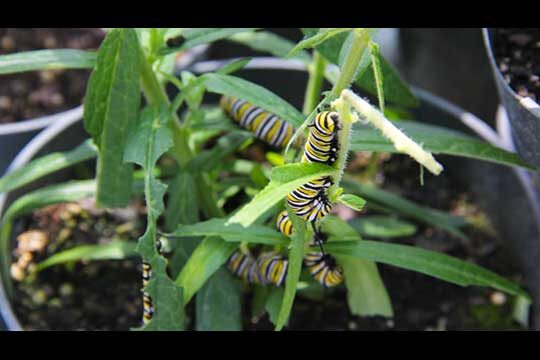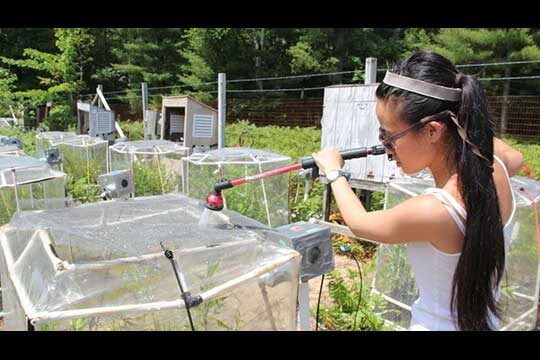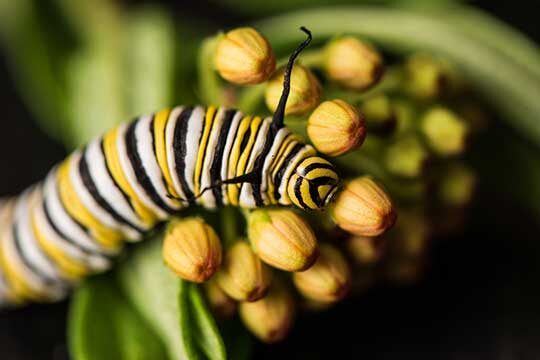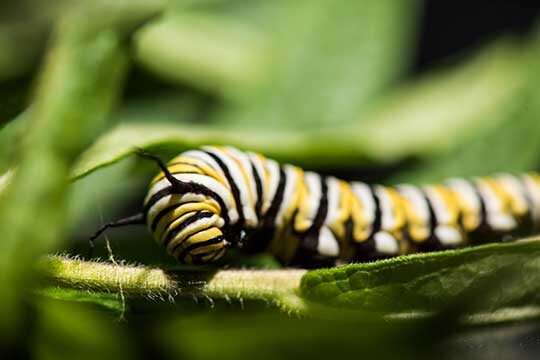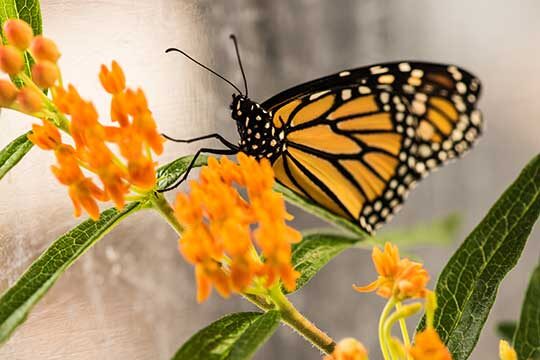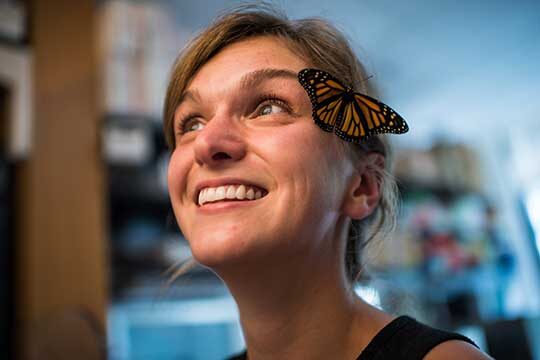The butterfly effect
U-M researchers in the Department of Ecology and Evolutionary Biology, including doctoral student Leslie Decker (pictured here), are studying the impacts of elevated carbon dioxide levels on the health of future monarch populations. Read more or watch a video about the work. (Text by Jim Erickson.)
-
On the one hand
Professor Hunter says the number of monarchs at the Biological Station has declined over the nine years he’s been studying them. In 2013, not a single monarch was observed at the station, though they’ve returned during the last two summers. “What we’re seeing here is part of a regional decline in the Upper Midwest that seems to be tied to the loss of milkweed plants around the edges of agricultural fields,” he says. “When milkweed disappears, so do the monarchs.” (Image: Levi Stroud, Michigan News.)
-
On the nose
U-M doctoral student Leslie Decker is part of a research team looking at milkweed, the sole food source of the monarch caterpillar. Milkweed satisfies the monarch’s nutritional needs while providing an invaluable medicinal boost. The plant’s leaves contain a bitter toxin that helps the insects ward off predators and parasites. But some species of milkweed produce lower levels of the protective toxins, called cardenolides, when grown under elevated carbon dioxide conditions. (Image: Austin Thomason, Michigan Photography.)
-
Color-coordinated
Most discussions of the monarch’s plight focus on habitat loss: the logging of trees in the Mexican forest where monarchs spend the winter, as well as the loss of wild milkweed plants that sustain them during their annual migration across North America. The U-M study examines how changes in atmospheric carbon dioxide levels could alter toxin concentrations in four milkweed species and, in turn, how exposure to those plants could affect the monarch’s life span and its susceptibility to disease. (Image: Levi Stroud, Michigan News.)
-
Lab test
Researchers are working in the lab of ecologist Mark Hunter, a professor in the Department of Ecology and Evolutionary Biology. Based at the U-M Biological Station in Northern Michigan, they created an experimental system that allowed them to manipulate and measure all the key links in the chain impacting the monarch population: carbon dioxide levels, toxin concentrations in milkweed leaves, infection by parasites, and monarch susceptibility to those parasites. (Image: Levi Stroud, Michigan News.)
-
Solo routine
Four species of milkweed were grown in special chambers at the Biological Station. Half the plants received normal levels of carbon dioxide, around 400 parts per million, and the other half got nearly double that amount. The researchers then measured the levels of cardenolide toxins in the various plant tissues, in order to know the exact dose each caterpillar would receive. “This is a way to determine how elevated CO2 changes the chemistry of these [milkweed] plants and how those changes work their way up the food chain,” Decker says. (Image: Austin Thomason, Michigan Photography.)
-
Nature calls
In the wild, parasite-infected female monarch butterflies sometimes seek out milkweed plants with high toxin levels and lay their eggs there, a process known as trans-generational self-medication.
“It turns out that many kinds of animals self-medicate,” says Professor Hunter. “In other words, they use chemicals in the environment to help them with their own parasites and diseases. And of course, humans have been doing that for a very long time — we still obtain about half of our new pharmaceutical drugs from plants.” (Image: Austin Thomason, Michigan Photography.) -
Leafing through
The U-M Biological Station is in Emmet County, at the northernmost tip of Michigan’s Lower Peninsula. Emmet County is home to four of the 12 species of milkweed that grow in Michigan, and it once held North America’s highest concentration of the plants, according to Professor Hunter. During World War II, the area became the nation’s picking and processing center for milkweed floss, which was used in military life vests. (Image: Austin Thomason, Michigan Photography.)
-
Chrysalis in a cup
In Michigan, monarch butterflies typically live for about a month. At their hilltop Biological Station lab this summer, Decker and Professor Hunter raised 480 adult monarch butterflies from eggs. Most of them died by the end of August, and the lifespan of each individual was recorded. (Image: Levi Stroud, Michigan News.)
-
Sitting pretty
“This study of monarch butterflies has broader implications,” says Professor Hunter. “If elevated carbon dioxide reduces the concentration of medicines in the plants that monarchs use, it could be changing the concentration of drugs for all animals that self-medicate, including humans. When we play Russian roulette with the concentration of atmospheric gases, we are playing Russian roulette with our ability to find new medicines in nature.” (Image: Austin Thomason, Michigan Photography.)
-
Fashion forward
If the study reveals that a certain species of milkweed could help future generations of monarchs battle parasites, it might be possible to fashion a management plan that calls for planting the beneficial milkweed species to help heavily infected monarch populations. “A lot of people reared monarch butterflies as children and still have a sentimental attachment to them,” says Decker. “So our work may motivate some people to care more about the ways global change is altering our world.” (Image: Austin Thomason, Michigan Photography.)



